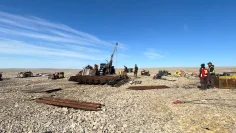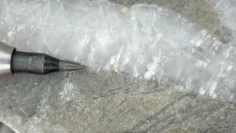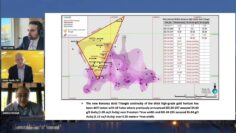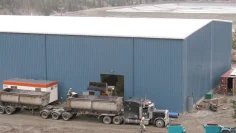Sonoro Gold – a Bargain Priced Low Risk Gold Mine Developer with Big Profit Potential
Everyone likes bargains, even better if the bargain turns out to be a multi-year growth story, a proverbial gift that just keeps giving. This could be Sonoro Gold Corp. (WKN A2QCST / TSXV SGO) which is developing a major gold deposit at its Cerro Caliche project in Sonora State, Mexico where it expects to begin producing gold as a heap leach mining operation (HLMO) late this year, or in early 2022.
So Why is it a Bargain?
Very few juniors are on the cusp of becoming gold producers and Sonoro is in a sweet spot where the relative risk is quite low and the potential share price increase is substantial.
The company is near the conclusion of multi-year program of intensive studies regarding whether or not it should build and operate a heap leach mine at its Cerro Caliche project. This means everything from engineering and metallurgy to costing the contractors who would do the mining and processing. By this June, it should have the official details of the results, which Sonoro’s highly credible executive advises, are to be very positive. One last outstanding question is what the recovery rate for deeper gold mineralization is and a few weeks ago, this too was partially answered with a bottle roll test which, at 82%, is 10% higher than the 72% recovery rate assumed for the project.
Key to this story, and for investors a possible, compelling reason to start accumulating Sonoro shares, is that should Sonoro commence production on schedule by next year, its annualized free cash flow per share has the potential to be higher than its current CDN $0.19 share price. It is important to note that gold producers often trade at several times their respective per share free cash flows. If this is the case, then an explosive increase in Sonoro’s share price becomes an increasingly possible outcome.
Manageable Risks
With every reward there are always risks, and in this case, the principal risks, assuming the gold price stays relatively stable, are as follows:
• Will this management, who have already either discovered, developed and/or operated more than a dozen gold deposits or mines in the region, be successful or not?
• Will the proposed mine operate with the same costs relative to the other heap leach mines in the area or is there some unseen issue that would reduce or eliminate profitability?
Perhaps after a dozen successes for the Sonoro executive, this is the one that does not work? Or as unluckily, despite being a near surface oxide gold deposit like its neighbors, the cost of getting the gold out of the ground and processing it will be much higher? This of course would affect Sonoro’s ability to finance. Furthermore the ‘official answers’ in the form of an independent resource study and Preliminary Economic Assessment (PEA) are due this July, we have already seen many solid indications that the Cerro Caliche will be yet another of their many successful mine developments. In other words the real opportunity is right now, with what we see as a relatively low risk bet on a storied team with four decades of finding and building some of northern Mexico’s most profitable mines. The metrics which follow illustrate what the profit potential is, and it is considerable. Maybe if gold’s price keeps going up, that then is a whole other very bullish story.
Justifiable Upside
Keeping our feet on the ground, we must justify why Sonoro’s shares could trade at a multiple of its potential future cash flow. As stated, the reality is most small cap gold producers’ shares trade at a big premium to free cash flow. Given the difficulty of finding new gold deposits these days, the number of these juniors is shrinking rapidly. Bigger companies are buying them for their gold reserves.
For example, two of Sonoro’s neighbors, Premier Gold Mines and Alio Gold, were taken over by larger gold producers during the past year. They are not alone. As more are bought, those still standing should be worth even more. Of the remaining, we used Torex Gold and Galiano Gold as examples of what can reasonably be expected. Torex has a cash flow multiple of 4 and Galiano’s is a slightly smaller 3.5.
Detective Work, a lot of Reading, Math and a Little Logic
Assuming that Sonoro’s warrants and options are all exercised, thereby adding CDN $18 million to the treasury, we would anticipate total shares issued and outstanding by the start of production to be approximately 150 million. Sonoro says its work is focused on the conceptual design of an up to 20,000 ton per day operation. To be conservative, we are basing the potential cash flow generated during the first year on a smaller operation: 15,000 tons per day, using 0.5 grams Au per ton which is the average grade in an already published 200,000 ounce Au 43-101 resource study. According to company news releases, thousands of meters of drilling have since indicated that a material increase in the gold resource should be expected with original 0.5 grams of gold per ton grade being “maintained”. Therefore, it is not a big leap of faith to expect the added drilling results to justify at least five years of production. We would expect that Sonoro’s management has increased the size of its proposed mine for the same reason.
To be safe we are using the smaller production rate. Even with the lower rate the results are already quite astounding. To get a ballpark idea of a reasonable target, I assume that the mine will operate for at least 320 days in a year and 72% of the gold contained in the mined mineralization will be recovered. Based on this, Sonoro’s first year of production should total approximately 50,000 net ounces of gold. On that basis, using a production rate of 50,000 ounces per year and a gold price of USD $1,700, the gross cash flow would be USD $85 million (CDN $107 million) or approximately CDN $0.70 per share. But this is only half of the story. More important is what are the costs of producing the gold likely to be? Management says they anticipate that costs will be essentially the same as other heap leach mines in the area. Therefore, what is a reasonable expectation?
Kleinvieh macht auch Mist (Small amounts add up to something bigger)
Years ago, 0.5 grams of gold per ton was considered a minuscule amount of gold, but now it can mean a very profitable mining opportunity. Take Sonoro’s neighbor Argonaut Gold, its operations give an accurate idea of the new normal for gold mining in the 21st century. Argonaut just published its financials which show an average gold grade to the leach pad of 0.28 grams per ton with a gold production cash cost (AISC) that totals USD $1,244 per ounce. Sonoro’s 0.5 grade is nearly double Argonaut’s. Even still, Argonaut is making record profits. There are others such as Alamos Gold which says that at its Mulatos Mine, the cost per ounce to produce gold this year should be at most USD $1,110.
Because Sonoro’s gold grade is higher, we used a USD $1,200 per ounce gold AISC cash cost that is USD $44 less than Argonaut’s USD $1,244 per ounce. We could project lower costs but I think it is wise to allow for potential differences in the mine stripping ratios. If a USD $1,700 gold price is then used, the Cerro Caliche would generate an AISC cash flow target of USD $25 million in the first year. This USD $25 million is roughly CDN $32 million which divided by Sonoro’s 150 million shares (fully diluted) comes out to a per share AISC cash flow of CDN $0.21, $0.02 higher than the current price. Multiplied by the previously mentioned lower 3.5 per share cash flow multiple, we get an upside target of $0.73 per share. Critically, this could be just the start of a long-term growth story, the aforementioned ‘gift that keeps giving’. Sonoro plans to keep expanding the Cerro Caliche operation and growing cash flow while it develops other gold deposits in the area. Basically, if management has its way, this is just the beginning and Sonoro will experience multiple years of accelerating growth.
Why Are We so Confident?
We always follow the people. The first decision of a great mining executive is to pick a great mineable deposit to develop. They will know where to look, how to acquire the deposit and how to develop and successfully manage the resulting mining operation. Sonoro’s management includes some of the region’s most accomplished mine builder-operators. Therefore, it will be no surprise when Cerro Caliche becomes yet another of the dozen or so gold deposits they have either discovered, developed or mined.
For example, Sonoro’s head of development is an engineer named Jorge Diaz and he has developed and operated mines since the 1980s, beginning with Glamis Gold (bought by Gold Corp. for $8.6bn). Glamis grew into a giant because of its ability to find, acquire and quickly build very low-cost heap leach gold mines and then operate them ultra-efficiently. This is what Sonoro’s executive are proven experts at doing. One of Diaz’s projects was Alamos Gold’s Mulatos Mine which has produced more than 2 million ounces of gold and is easily one of the area’s most successful heap leach operations. Sorono’s executive also includes Curtis Turner, a former senior executive from Argonaut Gold, which also took over Alio Gold one of the area’s highly successful low-cost heap leach mid-cap gold producers. In 2011, Argonaut also took over, at a premium, Pediment Gold, providing nearly 1000% profits to early investors. Sonoro’s VP of Exploration, Mel Herdrick, led the development of the two gold mines which were the only assets that made Pediment worth buying. He has had multiple successes in the region and Sonoro is his next focus. There are other very accomplished mine developers that are part of the company, but we think you already get the idea.
Zeit ist Geld
Time is money and timing is everything. If a project is too far in the future or the timing is unknowable, it will be worth less and even the waiting can be a compounding risk. Sonoro’s storied management is very clear about the project’s timeline, which is on its website. The timeline in turn indicates we may have a very narrow window of opportunity, only months or perhaps weeks, before its shares may begin to rise explosively. They are ‘fast-tracking’ the Cerro Caliche mine development with the intent of starting gold production around the end of this year.
To learn about its highly skilled development team and then read the company’s news releases, it becomes apparent that they have already done considerable metallurgical, engineering and design work to both ensure the Cerro Caliche’s viability and accelerate its development. This means it is likely to be relatively soon when the market wakes up to the opportunity. But how soon? The most prominent potential catalyst are Sonoro’s plans to release to the public around this June the results of a resource update, geological engineering and metallurgical studies, together with a Preliminary Economic Assessment (PEA) which summarizes the entire project’s economics. With this information, the proverbial cat should be out of the bag and Sonoro’s shares should have every reason to trade substantially higher.
A Low Hurdle Points to an Easy Start
To minimize the capital cost of the mine for the first 18-24 months of operation, part of Sonoro’s strategy is to minimize the capital costs by employing the area’s best in class contract miners’ and mineral processors. As you know, Sonoro’s key management has been operating in the area since the 1980s, consequently they are among the best placed to successfully outsource:
a) mining, excavation & grinding circuit prior to leaching,
b) production of carbon instead of dore (reduces risk of theft), and
c) using generators instead of extending a nearby transmission line.
Looking at the prefeasibility study for Argonaut’s 16,000 ton per day Cerro del Gallo (CDG) heap leach project in Guanajuato, Mexico, we can get some idea of the costs Sonoro will have avoided and what the CAPEX costs may be. For example, the first two stages of the grinding circuit at CDG are priced at USD $10.1 million, a cost Sonoro avoids by subcontracting. The principal pre-production CAPEX left is the heap leach pad and stacking system and solution handling, site, utilities and a laboratory. Sonoro’s lab is likely to be a lot smaller given the much simpler operation and the same can be said for its solution handling costs. Not counting the lab and using the CDG costs, gives us a ball-park preproduction capex supply cost starting around USD $14 million. But, Sonoro is a much more logistically convenient area than Guanajuato and the metallurgy much simpler so, if anything, these costs could be on the high side. We will know in June of this year.
Exceptional Economic Potential Makes for a Compelling Investment Story
Key to this exercise is that the potential economics are compelling. Using the CDG derived costs of USD $14 million and the projected annualized free cash flow of USD $25 million, the CAPEX is recovered in less than seven months. Such a fast payback should make the mine’s debt financing a snap. However for investors, it is the potential commencement of revenues and accelerating organic growth that really might make Sonoro’s shares worth buying. Add to this the potential to increase the gold deposit’s size enough to extend production for another decade. The reality is that less than 20% of the Cerro Caliche’s 14 square kilometers’ worth of shallow oxide gold zones have been drilled so, as is the case with many mines, Sonoro should continue to grow with more drilling as gold is produced. Management also plans to develop a nearby property called San Marcial and other projects like it. For investors to make big profits, all Sonoro’s executives need to do is to continue doing what they have been doing with other companies for the past 40 years: develop and grow the Cerro Caliche into another major mining success.
We believe that Sonoro shares really are in a sweet spot where the relative risk is quite low and the potential share price increase is substantial. It is an opportunity which we think is unlikely to last much longer.
Disclaimer: GOLDINVEST Consulting GmbH offers editors, agencies and companies the possibility to publish comments, analyses and news on https://www.goldinvest.de. This content exclusively serves to inform the readers and does not represent any kind of call to action, neither explicitly nor implicitly is it to be understood as an assurance of possible price developments. Furthermore, they in no way replace an individual expert investment advice, it is rather promotional / journalistic publications. Readers who make investment decisions or carry out transactions on the basis of the information provided here do so entirely at their own risk. The acquisition of securities carries high risks, which can lead to the total loss of the invested capital. The GOLDINVEST Consulting GmbH and its authors expressly exclude any liability for financial losses or the content guarantee for topicality, correctness, adequacy and completeness of the articles offered here. Please also note our terms of use.
According to §34b WpHG and according to paragraph 48f paragraph 5 BörseG (Austria) we would like to point out that principals, partners, authors and employees of GOLDINVEST Consulting GmbH hold or may hold shares of Sonoro Gold and therefore a possible conflict of interest exists. We also cannot exclude that other stock letters, media or research firms discuss the stocks we recommend during the same period. Therefore, symmetrical information and opinion generation may occur during this period. Furthermore, there is a consulting or other service contract between a third party that is in the camp of Sonoro Gold and GOLDINVEST Consulting GmbH, which means that there is a conflict of interest, especially since this third party remunerates GOLDINVEST Consulting GmbH for reporting on Sonoro Gold. This third party may also hold, sell or buy shares of the issuer and would thus benefit from an increase in the price of the shares of Sonoro Gold. This is another clear conflict of interest.













